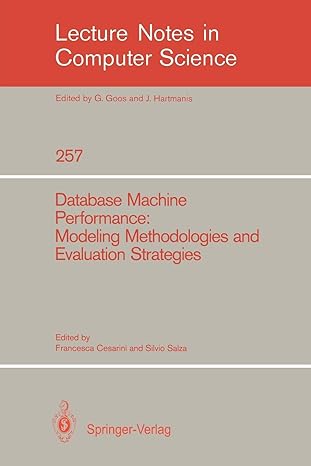Question
I need to create a program that will help manage a collection of recipes. The Recipe class I build for this milestone will hold all
I need to create a program that will help manage a collection of recipes. The Recipe class I build for this milestone will hold all the details of the recipe, the methods to create a new recipe, and a method to print a recipe. In your final project submission, this class will also contain a custom method to add a new feature. In your submission for Milestone Two, you will include commented out pseudocode for this method.
Prompt: In this milestone, you submit the final project version of your Recipe class. Your submission should include the Recipe.java file and a Recipe_Test.java file.
Your Recipe class should include the following items: ?
Instance variables: recipeName, servings, recipeIngredients, and totalRecipeCalories ? Accessors and mutators for the instance variables ? Constructors ? A printRecipe() method ? A createNewRecipe() method to build a recipe from user input ? Pseudocode for the custom method selected from the list in Stepping Stone Lab Five
Your Recipe_Test.java file containing a main() method that: ?
Uses a constructor to create a new recipe ? Accesses the printRecipe() method to print the formatted recipe ? Invokes the createNewRecipe() method to accept user input
Specifically, the following critical elements of the final project are addressed:
I. Data Types: Your Recipe class should properly employ each of the following data types that meet the scenarios requirements where necessary: A. Utilize appropriate numerical and string data types to represent values for variables and attributes in your program. B. Populate a list or array that allows the management of a set of values as a single unit in your program.
II. Algorithms and Control Structure: Your Recipe class should properly employ each of the following control structures as required or defined by the scenario where necessary: A. Utilize expressions or statements that carry out appropriate actions or that make appropriate changes to your programs state as represented in your programs variables. B. Employ the appropriate conditional control structures that enable choosing between options in your program. C. Utilize iterative control structures that repeat actions as needed to achieve the programs goal.
III. Methods: Your Recipe class should properly employ each of the following aspects of method definition as determined by the scenarios requirements where necessary: A. Use formal parameters that provide local variables in a functions definition. B. Use actual parameters that send data as arguments in function calls. C. Create both value-returning and void functions to be parts of expressions or stand-alone statements in your program. D. Invoke methods that access the services provided by an object. E. Describe a user-defined method that provides custom services for an object. F. Create unit tests that ensure validity of the methods.
IV. Classes: Construct classes for your program that include the following as required by the scenario where necessary: A. Include attributes that allow for encapsulation and information hiding in your program. B. Include appropriate methods that provide an objects behaviors.
V. Documentation: Utilize inline comments directed toward software engineers for the ongoing maintenance of your program that explain the decisions you made in the construction of the classes in your program. Rubric Guidelines for Submission: Your complete program should be submitted as a zip file of the exported project containing the Recipe.java and Recipe_Test.java files.
package Milestone1;
import java.util.Scanner;
public class Ingredient { private String name; private double amount; private String unitOfMeasure; private int calories;
private Scanner sc = new Scanner(System.in);
public Ingredient() { System.out.println("Please enter the name of the ingredient: "); name = sc.nextLine();
System.out.println("Please enter the number of cups of " + name + " we'll need: "); boolean valid = false;
while(!valid) { try { amount = Double.parseDouble(sc.nextLine()); valid = true; } catch(Exception e) { System.out.println("Invalid value. Try again: "); } }
System.out.println("Please enter the unit of measure: "); unitOfMeasure = sc.nextLine();
System.out.println("Please enter the number of calories per cup: "); valid = false; while(!valid) { try { calories = Integer.parseInt(sc.nextLine()); valid = true; } catch(Exception e) { System.out.println("Invalid value. Try again: "); } } }
public String getName() { return name; }
public double getAmount() { return amount; }
public int getCalories() { return calories; }
public String getUnitOfMeasure() { return unitOfMeasure; }
@Override public String toString() { return "Ingredient [name=" + name + ", amount=" + amount + ", unitOfMeasure=" + unitOfMeasure + ", calories=" + calories + "]"; }
public static void main(String args[]) { Ingredient i = new Ingredient(); System.out.println(" " + i); } }
Step by Step Solution
There are 3 Steps involved in it
Step: 1

Get Instant Access to Expert-Tailored Solutions
See step-by-step solutions with expert insights and AI powered tools for academic success
Step: 2

Step: 3

Ace Your Homework with AI
Get the answers you need in no time with our AI-driven, step-by-step assistance
Get Started


